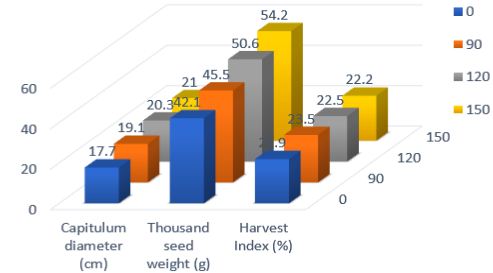Utilizing Capitulum Coverings Along with Application of Nitrogen and Phosphorus Enhances the Seed Yield of Sunflower
Keywords:
Sunflower, Nitrogen, Phosphorous, Capitulum CoveringAbstract
sunflower is an important oil crop whose production needs to be boosted by optimum nutrition. Understanding the responsive connection between nutrients and sunflower output is critical for its prudent management and maintaining higher yields. In this regard, an experiment using a randomized complete block design (RCBD) with split-plot arrangements and three replications was conducted at the Agriculture Research Station in Harichand, Charsadda, in 2022. Treatments included various levels of nitrogen and phosphorus, along with different capitulum coverings: muslin cloth, paper envelopes, and uncovered heads. Nitrogen and phosphorus treatments were assigned to main plots, while capitulum coverings were assigned to subplots. Results showed that the nitrogen at the rate of 150 kg ha⁻¹ and phosphorous at the rate of 90 kg ha⁻¹ significantly increased capitulum diameter, disk weight, seeds per capitulum, thousand-seed weight, final plant population at harvest, and seed yield compared to lower nitrogen and phosphorous rates. Nitrogen and phosphorus levels were not significantly associated with seed loss per capitulum. Muslin cloth covering of the capitulum significantly improved yield components, including seeds per capitulum, reduced seed loss per capitulum, seed yield, and harvest index, compared to paper envelope and uncovered treatments. The interaction of nitrogen and phosphorus levels significantly enhanced capitulum diameter, disk weight, seed yield, and harvest index. Based on these results, it is recommended to apply nitrogen at 150 kg ha⁻¹ and phosphorus at 90 kg ha⁻¹, with capitulum coverings using muslin cloth, to maximize yield and yield components of sunflower.


















